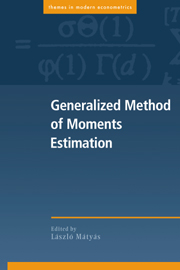Book contents
- Frontmatter
- Contents
- Contributors
- Preface
- 1 Introduction to the Generalized Method of Moments Estimation
- 2 GMM Estimation Techniques
- 3 Covariance Matrix Estimation
- 4 Hypothesis Testing in Models Estimated by GMM
- 5 Finite Sample Properties of GMM estimators and Tests
- 6 GMM Estimation of Time Series Models
- 7 Reduced Rank Regression Using GMM
- 8 Estimation of Linear Panel Data Models Using GMM
- 9 Alternative GMM Methods for Nonlinear Panel Data Models
- 10 Simulation Based Method of Moments
- 11 Logically Inconsistent Limited Dependent Variables Models
- Index
8 - Estimation of Linear Panel Data Models Using GMM
Published online by Cambridge University Press: 04 February 2010
- Frontmatter
- Contents
- Contributors
- Preface
- 1 Introduction to the Generalized Method of Moments Estimation
- 2 GMM Estimation Techniques
- 3 Covariance Matrix Estimation
- 4 Hypothesis Testing in Models Estimated by GMM
- 5 Finite Sample Properties of GMM estimators and Tests
- 6 GMM Estimation of Time Series Models
- 7 Reduced Rank Regression Using GMM
- 8 Estimation of Linear Panel Data Models Using GMM
- 9 Alternative GMM Methods for Nonlinear Panel Data Models
- 10 Simulation Based Method of Moments
- 11 Logically Inconsistent Limited Dependent Variables Models
- Index
Summary
Use of panel data regression methods has become increasingly popular as the availability of longitudinal data sets has grown. Panel data contain repeated time series observations (T) for a large number (N) of cross sectional units (e.g., individuals, households, or firms). An important advantage of using such data is that they allow researchers to control for unobservable heterogeneity, that is, systematic differences across cross sectional units. Regressions using aggregated time series and pure cross section data are likely to be contaminated by these effects, and statistical inferences obtained by ignoring these effects could be seriously biased. When panel data are available, error components models can be used to control for these individual differences. Such a model typically assumes that the stochastic error term has two components: a time invariant individual effect which captures the unobservable individual heterogeneity and the usual random noise term. Some explanatory variables (e.g., years of schooling in the earnings equation) are likely to be correlated with the individual effects (e.g., unobservable talent or IQ). A simple treatment to this problem is the within estimator which is equivalent to least squares after transformation of the data to deviations from means.
Unfortunately, the within method has two serious defects. First, the within transformation of a model wipes out time invariant regressors as well as the individual effect, so that it is not possible to estimate the effects of time invariant regressors on the dependent variable. Second, consistency of the within estimator requires that all the regressors in a given model be strictly exogenous with respect to the random noise.
- Type
- Chapter
- Information
- Generalized Method of Moments Estimation , pp. 211 - 247Publisher: Cambridge University PressPrint publication year: 1999
- 12
- Cited by



